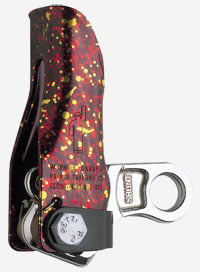 Here at Roco, we have recently discovered a minor issue when the SKED stretcher is updated with Cobra buckles. The Cobra buckle replacement system is attached by girth-hitching the components into the grommets. The girth hitch takes up more room in the grommets than the sewn loop that was previously used. This makes it more difficult to pass the vertical bridle rope through the grommet holes that we’re accustomed to using.
Here at Roco, we have recently discovered a minor issue when the SKED stretcher is updated with Cobra buckles. The Cobra buckle replacement system is attached by girth-hitching the components into the grommets. The girth hitch takes up more room in the grommets than the sewn loop that was previously used. This makes it more difficult to pass the vertical bridle rope through the grommet holes that we’re accustomed to using.
Skedco was contacted and has approved the following alternative method (see photo). After tying a square knot at the bottom of the SKED, bring the tail ends of the rope back up and pass them through the bottom grommet hole of the handles before tying the second square knot. Note: “Handle” holes may be used with the old style buckle system.


 Petzl has published a statement addressing special use of the Petzl Shunt as a back-up device for industrial rope access. For any users of the Petzl Shunt as a self-belay device such as tower rescuers, the same information applies.
Petzl has published a statement addressing special use of the Petzl Shunt as a back-up device for industrial rope access. For any users of the Petzl Shunt as a self-belay device such as tower rescuers, the same information applies. In 1969, Fernand, with my brother Peter, started manufacturing a descender and a belay device designed by a caver named Bruno Dressler. This time was also a turning point in caving, as ropes replaced ladders as the sole means of vertical movement. This technique had already been developed by Jumar, for mountaineering, but cavers took the technique and adapted it for underground use. And this is how Petzl began…in my father’s 75 square meter workshop. My family – my father, mother, brother, wife, and I – designed the first tools for verticality and the first underground lamps, which lead, in 1972, to the Petzl headlamp.
In 1969, Fernand, with my brother Peter, started manufacturing a descender and a belay device designed by a caver named Bruno Dressler. This time was also a turning point in caving, as ropes replaced ladders as the sole means of vertical movement. This technique had already been developed by Jumar, for mountaineering, but cavers took the technique and adapted it for underground use. And this is how Petzl began…in my father’s 75 square meter workshop. My family – my father, mother, brother, wife, and I – designed the first tools for verticality and the first underground lamps, which lead, in 1972, to the Petzl headlamp. We're often asked about using training rope for rescue purposes, so here's what we discovered...
We're often asked about using training rope for rescue purposes, so here's what we discovered... The newly revised Roco Pocket Guide features fifty-eight pages of color illustrations of the actual techniques and systems taught in our classes.
The newly revised Roco Pocket Guide features fifty-eight pages of color illustrations of the actual techniques and systems taught in our classes. 


